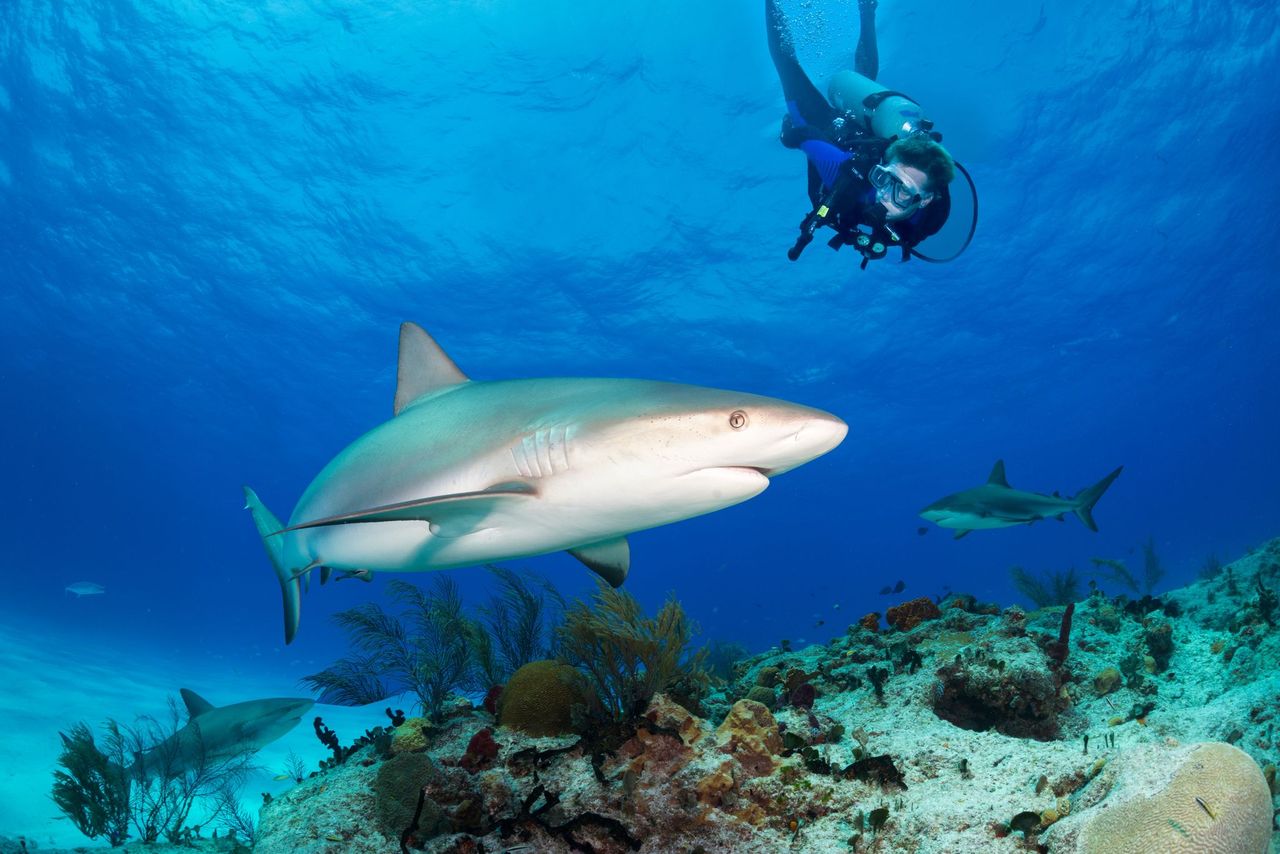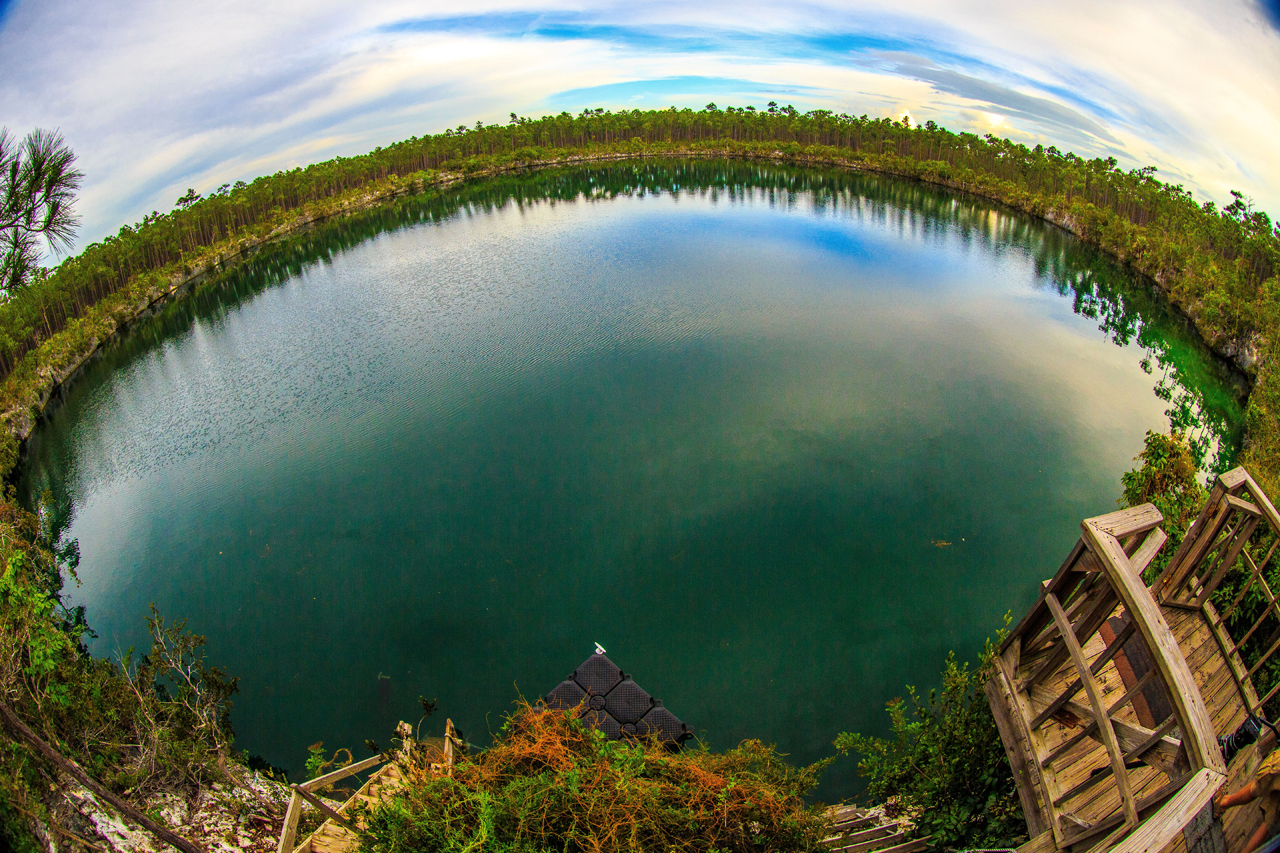
A DIVER'S GUIDE TO THE BAHAMAS
Spreading some 600 miles north to south and 200 miles east to west, the 700 islands of the Bahamas are a diver’s and fisherman's playground and a beach-lover's dream. There's a vacation experience for every taste and budget, from five-star resorts to quiet guest houses on deserted beaches. The underwater scene is equally diverse, offering something for snorkelers, recreational divers, explorers and adventure seekers alike. Here is a sample of what divers can discover in the waters of the Bahamas.

REEFS
The Bahamas has more coral reefs than the entire Caribbean. Nearly 20,000 square miles of reefs await discovery by divers. Shallow patch reefs create oases of life where divers can devote hours of bottom time to searching for tiny treasures; reef crests adorned with stands of branching elkhorn coral transition to slopes and ledges encrusted with colorful displays of sponges, hard and soft coals, creating ideal conditions for multi-level profiles; grottoes formed by the ebb and flow of currents invite exploration; coral-encrusted pinnacles rise from deep water to attract passing pelagics.

WALLS
The islands of the Bahamas are the tops of huge limestone plateaus that rise abruptly from the depths of the Atlantic Ocean. The edges of these plateaus form sheer cliffs that drop to depths of a mile or more. Sunshine and clear waters reveal the full scope of these rampart-like formations. Diving the faces of these underwater walls is a sensation akin to flying, as divers hang weightless, suspended above the void. And because these walls face deep water, there is always the chance that something big will come cruising in from the blue.
WRECKS

Shipwrecks add an element of intrigue to any dive, and the Bahamas has its share of sunken vessels. Some were victims of storms or human error, others were sent to the bottom intentionally to create fish havens and diving attractions. Cargo vessels are the most common members of this ghost fleet, but there are also historic shipwrecks, island sloops, ill-fated aircraft and even a Civil War-era train. Over time, many of these wrecks have acquired a patina of coral and sponge growth and now harbor a menagerie of marine life. Because the vast majority of Bahamas shipwrecks rest in clear water at moderate depths, they are suitable for almost all open water divers.

SHARKS
The Bahamas is synonymous with shark encounters. Dive operators stage feeding dives that attract swirling clouds of reef sharks. But that's just the beginning. Reef sharks can be found on a variety of dive sites. These sleek predators patrol the boundaries of coral reefs in search of their natural prey — which, by the way, is fish, cephalopods and crustaceans — not humans. Chance encounters with hammerhead sharks occur during wall dives, and annual gatherings of these sharks occur in the waters near Bimini. Bigger thrills await at locations such as the famed Tiger Beach, where divers can rub fins with lemon sharks, hammerheads and large tiger sharks. Even more exciting are blue water dives with species ranging from silky sharks to oceanic whitetips.
DOLPHINS

Swimming or diving with a pod of wild dolphins is a truly magical experience and a far cry from staged encounters at dolphin parks. In their natural environment, dolphins are curious, playful creatures that often initiate contact with humans. Divers may have chance encounters with free-swimming dolphins at sites across the Bahamas, but there are certain areas where visits with these gregarious cetaceans are almost guaranteed. These include the waters near Freeport on Grand Bahama Island, and sand flats near Bimini and on the Little Bahama Bank.

BLUE HOLES
The Bahamas' limestone substrate is riddled with flooded caverns and voids. These water-filled chambers open to the surface as blue holes, and they can be found both on land and in surrounding waters. Some holes are the entrance to massive cave systems which extend for miles underground. But divers don't have to venture into these dark realms to experience the magic of blue hole diving. The entrances and light-filled caverns of a blue provide unique diving experiences that can be enjoyed by all.
SNORKELING

You don't need tanks to enjoy the underwater riches of the Bahamas. With just a mask, snorkel and fins, you can turn surface intervals into additional water time. All across the archipelago, reefs rise to within a few feet of the surface to create ideal conditions for snorkeling. Limestone ledges and grass beds add additional variety to the seascape, and many sites can be reached by a short swim from the beach. For something different, snorkelers can visit the famed Bimini Road, fin across the world's deepest blue hole or tour an underwater sculpture garden.
NEW PROVIDENCE
The beachfront resorts of New Providence Island offer glittering casinos, gourmet dining, historic attractions and vibrant nightlife. In the Bahamian capital of Nassau, hoppers can scan for upscale bargains at duty-free shops or take home handmade mementos from a straw market. Across the island on the calm southern shore, dive boats depart for quick runs across a sand and coral plane that boasts more than 30 dive-able shipwrecks, some lying in as little as 40 feet of water, and none beyond comfortable recreational depths. And there are sharks. Stuart Cove's Dive Bahamas operates one of the world's most popular shark encounters. At sites such as Shark Wall, The Arena, and Runway, Caribbean reef sharks put on thrilling displays when lured in with the promise of a snack. In addition to these staged feeds, reef sharks can often be seen cruising coral reefs and patrolling near wrecks.

GRAND BAHAMA
Perched on the edge of the Little Bahama Bank, Grand Bahama Island is home to Freeport, the nation's second largest city and a favorite destination for cruise ship passengers and duty-free shoppers. The island's southern shore is lined with miles of white sand beaches, and deep water isn't far offshore. Dive centers in the Freeport area visit a range of sites that begin just minutes from the dock. Grand Bahama has long been known for coordinated dolphin encounters in open water, and shark feeds that attract large numbers of Caribbean reef sharks. There are protected nearshore reefs, a number of diveable shipwrecks in the middle depths, and wall dives that begin just a mile from shore. Cavern divers can coordinate trips to blue holes and all-day charters to swim with wild dolphins or come face-to-face with tiger and lemon sharks at the world-famous sites of Tiger Beach.
BIMINI
Sitting less than 50 miles from Miami, Bimini is the gateway to the Bahamas. Private boats, ferries, seaplanes and regular air service bring divers and fishermen to these Islands in the Stream, where the shallow waters of the Bahama Banks meet the deep blue flow of the Gulf Stream. This convergence provides divers with a wide range of underwater experiences that include shallow wrecks, mid-depth reefs teeming with life, slopes cut by winding ravines and deep walls. Sites such as Tuna Alley are swarmed by large schools of jacks, snappers, and grunts, and patrolled by predators like reef sharks, sea turtles, eagle rays and groupers. Bimini has added another claim to fame. During the winter season to early spring, divers have the unique opportunity to swim with large great hammerhead sharks as they are baited from deep water.
ANDROS

The largest Bahamian island is a land of low-lying pine forests, winding tidal creeks and deserted beaches. Andros lures cavern and cave divers with the Bahamas’s largest collection of blue holes. They offer experiences for open water divers as well. The tidal exchange at the entrances to oceanic blue can attract large schools of fish and promote oasis-like coral growth around their entrances. Andros has more to offer than holes in the ground. The island’s east coast is flanked by hundreds of square miles of shallow reefs and coral heads, providing hours of relaxing submersions in bright coral gardens, and shark dives on the adjacent sand flats. A mile to the east, the sea floor drops away to depths of more than a mile along the edge of the Tongue of the Ocean. Dives along this boundary line adds the chance for encounters with pelagic species that cruise the edge of the wall.
THE EXUMAS
The Exuma chain stretches 120 miles north-to-south through the central Bahamas. There’s deep water to the east and large sand flats to the west. In between are the protected sites of the Exumas Land and Sea Park. Shallow to mid-depth reefs are festooned with a variety of both hard and soft coral and populated by moray eels, lobster, nurse sharks, queen angels, parrotfish and grouper. There are a smattering of wrecks to explore, and outcroppings that hold shoals of jacks, grunts and snapper. Divers can explore the hidden caverns of Thunderball Grotto, featured in the classic James Bond film of the same name. The northern Exumas are a favorite with liveaboards departing from the Port of Nassau. Farther south, the shores of Great Exuma are a starting point for day trips to local reefs, some of which provide a chance for flight-like drift dives over fields of coral and giant sponges. There are also trips to the Great Exuma Wall and to blue holes and caverns such as Mystery Cave, the entrance to a passageway that runs from shore to shore beneath Stocking Island.

SAN SALVADOR
Low-lying, undeveloped and home to fewer than 1,000 people, San Salvador is a true escape from the everyday and a place where the star shine replaces streetlight glow. The big attraction for divers is miles of vertical walls that begin in depths as shallow as 40 feet. The scope of these cliff faces is made evident by water that is among the clearest in the Caribbean. And because most dive sites are found on the sheltered side of the island, the seas are usually calm. These conditions allow divers of all abilities to enjoy the experience. Divers who stay above the crest of the wall will meet the island’s gregarious Nassau groupers, which hover over groves of staghorn and elkhorn coral and glide through the creases and crevices of the upper reef. Divers who drop over the edge can choose their depth as they glide along wall faces perforated by overhangs and swim-through clefts. San Salvador is also known for hammerhead shark sightings, and there’s always the chance of a sighting when diving the edge of deep water.
Book and Save With Caradonna Adventures
Caradonna represents the Bahamas top dive operators and resorts. Our expert agents can provide information and advice, and arrange all the details of a dive vacation, including airfare. They are updated on the latest seasonal specials and package deals for Bahamas dive and beach vacations. To learn about current offers, call Caradonna Adventures at 800-330-6611 or send a note to sales@caradonna.com.